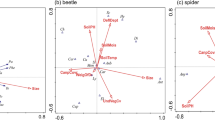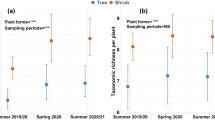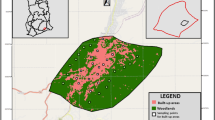Abstract
Urbanization is one of the most significant causes of habitat fragmentation on the planet, resulting in substantial losses of biodiversity and disruptions to ecological processes. We examined the effects of urbanization on the diversity and abundance of arboreal invertebrates in a dominant tree species (Angophora costata) in a highly urbanized landscape in Sydney, Australia, identifying the potential ecological consequences of shifts in diversity. We hypothesized that trophic structure would be influenced by landscape context with a greater richness and abundance of invertebrates in small remnants and edges. Canopy arthropods were sampled via beating from trees in 15 sites in three landscape contexts; five large patches of continuous vegetation, five edges of large patches and five small urban remnants. Trees in large patches supported fewer individuals compared to trees in small urban remnants and edge sites. The composition of assemblages and overall trophic structure also differed between edges and large patches, with a greater abundance of grazing insects in edges. No differences were detected between small urban remnants and edges, suggesting that observed differences might be attributed to an edge effect as opposed to an area effect per se. These changes in trophic structure, revealing a greater abundance of grazing herbivores and a reduced abundance of predators and parasitoids in edge sites, are consistent with work describing elevated levels of herbivory in edges of remnant vegetation. Future management of remnant urban vegetation and associated biodiversity requires not only an understanding of how trophic status influences the extent of responses by arboreal invertebrate communities, but also how these will affect ecosystem functioning.





Similar content being viewed by others
References
Benson D, Howell J (1990) Taken for granted: The bushland of Sydney and its suburbs, 1st edn. Kangaroo, Kenthurst
Boland DJ, Brooker MIH, Chippendale GM, Hall N, Hyland BPM, Johnston RD, Kleinig DA, Turner JD (2006) Forest trees of Australia, 5th edn. CSIRO, Collingwood
Bolger DT, Suarez AV, Crooks KR, Morrison SA, Case TJ (2000) Arthropods in urban habitat fragments in southern California: area, age and edge effects. Ecol Appl 10:1230–1248
Christie FJ (2004) Effects of urbanization on forest ecosystems: A multi-taxon approach to assessing impacts on remnant vegetation. PhD thesis The University of Sydney
Christie FJ, Hochuli DF (2005) Elevated levels of herbivory in urban landscapes: are declines in tree health more than an edge effect? Ecol Soc 10: URL: http://www.ecologyandsociety.org/vol10/iss1/art10/
Christie FJ, Hochuli DF (2009) Responses of wasp communities to urbanization: effects on community resilience and species diversity. J Insect Conserv 13:213–221
Clarke KR (1993) Non-parametric multivariate analyses of changes in community structure. Aust J Ecol 18:117–143
Clarke KR, Gorley RN (2001) PRIMER v5: User manual/tutorial. PRIMER-E, Plymouth
Clarke PJ, Reed JM, Chew FS (2007) Effects of urbanization on butterfly species richness, guild structure, and rarity. Urban Ecosyst 10:321–337
Colding J (2007) Ecological land-use complementation’ for building resilience in urban ecosystems. Landsc Urb Plan 81:46–55
Costermans L (1985) Native tress and shrubs of south-eastern Australia, 4th edn. Rigby, Australia
Dangerfield MJ, Pik AJ, Britton D, Holmes A, Gillings M, Oliver I, Briscoe D, Beattie AJ (2003) Patterns of invertebrate biodiversity across a natural edge. Austral Ecol 28:227–236
Foggo A, Ozanne CMP, Speight MR, Hambler C (2001) Edge effects and tropical forest canopy invertebrates. Plant Ecol 153:347–359
Gibb H, Hochuli DF (2002) Habitat fragmentation in an urban environment: large and small fragments support different arthropod assemblages. Biol Conserv 106:91–100
Grey MJ, Clarke MF, Lyon RH (1997) Initial changes in the avian communities of remnant eucalypt woodlands following a reduction in the abundance of Noisy Miners, Manorina melanocephala. Wildlife Res 24:631–648
Hatcher PE, Ayres PG (1997) Indirect interactions between insect herbivores and pathogenic fungi on leaves. In: Gange AC, Brown VK (eds) Multitrophic interactions in terrestrial systems. University Press, Cambridge, pp 133–149
Hochuli DF, Gibb H, Burrows SE, Christie FJ (2004) Ecology of Sydney’s urban fragments: Has fragmentation taken the sting out of insect herbivory? In: Lunney D, Burgin S (eds) Urban Wildlife: More than meets the eye. Royal Zoological Society of NSW, Mosman, pp 63–69
Joern A, Mole S (2005) The plant stress hypothesis and variable responses by blue grama grass (Bouteloua gracilis) to water, mineral nitrogen, and insect herbivory. J Chem Ecol 31:2069–2090
King SA, Buckney RT (2002) Invasion of exotic plants in nutrient-enriched urban bushland. Austral Ecol 27:573–583
Laman TG (1995) Safety recommendations for climbing rain forest trees with “Single Rope Technique”. Biotropica 27:406–409
Landsberg J (1990) Dieback of rural eucalypts: the effects of stress on the nutritional quality of foliage. Aust J Ecol 15:97–107
Landsberg J, Wylie F (1983) Water stress, leaf nutrients and defoliation: a model of dieback of rural eucalypts. Aust J Ecol 8:27–41
Leishman AJ (2000) A long-term banding study of birds in a spotted gum forest near Campbelltown, New South Wales. Corella 24:6–12
Liley D, Clarke RT (2003) The impact of urban development and human disturbance on the numbers of nightjar Caprimulgus europaeus on heathlands in Dorset, England. Biol Conserv. 114:219–230
Lill JT, Marquis RJ (2001) The effect of leaf quality on herbivore performance and attack from natural enemies. Oecologia 126:418–428
Lowman MD, Heatwole H (1992) Spatial and temporal variability in defoliation of Australian Eucalypts. Ecology 73:129–142
Magura T, Báldi A, Horváth R (2008a) Breakdown of the species-area relationship in exotic but not in native forest patches. Acta Oecol 33:272–279
Magura T, Tóthmérész B, Molnár T (2008b) A species-level comparison of occurrence patterns in carabids along an urbanisation gradient. Landsc Urb Plan 86:134–140
Major RE, Christie FJ, Gowing G, Cassis G, Reid CAM (2003) The effect of habitat configuration on arboreal insects in fragmented woodlands in south-eastern Australia. Biol Conserv 113:35–48
Marquis RJ, Whelan CJ (1998) Revelations and limitations of the experimental approach for the study of plant-animal interactions. In: Resetarits WJ Jr, Bernado J (eds) Experimental ecology: Issues and perspectives. Oxford University Press, New York, pp 416–436
McIntyre NE, Hostetler ME (2001) Effects of urban land use on pollinator (Hymenoptera: Apoidea) communities in a desert metropolis. Basic Appl Ecol 2:209–218
McIntyre NE, Rango J, Fagan WF, Faeth SH (2001) Ground arthropod community structure in a heterogeneous urban environment. Landsc Urb Plan 52:257–274
Murcia C (1995) Edge effects in fragmented forests: implications for conservation. Trends Ecol Evol 10:58–62
Niemelä J, Kotze J, Ashworth A, Brandmayr P, Desender K, New T, Penev L, Samways M, Spence J (2000) The search for common anthropogenic impacts on biodiversity: a global network. J Insect Conserv 4:3–9
Niemelä J, Kotze DJ, Venn S, Penev L, Stoyanov I, Spence J, Hartley D, Montes de Oca E (2002) Carabid beetle assemblages (Coleoptera, Carabidae) across urban-rural gradients: an international comparison. Landsc Ecol 17:387–401
Nuckols MS, Connor EF (1995) Do trees in urban or ornamental plantings receive more damage by insects than trees in natural forests? Ecol Entomol 20:253–260
Ozanne CMP, Hambler C, Foggo A, Speight MR (1997) The significance of edge effects in the management of forests for invertebrate biodiversity. In: Stork N, Adis J, Didham R (eds) Canopy arthropods. Chapman & Hall, London, pp 534–550
Pacheco R, Vasconcelos HL (2007) Invertebrate conservation in urban areas: ants in the Brazilian Cerrado. Landsc Urb Plan 81:193–199
Panzer R (2003) Importance of In Situ survival, recolonization, and habitat gaps in the postfire recovery of fire-sensitive prairie insect species. Nat Area J 23:14–21
Peeters PJ (2002) Correlations between leaf constituent levels and the densities of herbivorous insect guilds in an Australian forest. Austral Ecol 27:658–671
Perry DR (1978) A method of access into the crowns of emergent and canopy trees. Biotropica 10:155–157
Piper SD, Catterall CP (2003) A particular case and a general pattern: hyperaggressive behaviour by one species may mediate avifaunal decreases in fragmented Australian forests. Oikos 101:602–614
Pitkänen A, Kouki J, Viiri H, Martikainen P (2008) Effects of controlled forest burning and intensity of timber harvesting on the occurrence of pine weevils Hylobius spp., in regeneration areas. Forest Ecol Manag 255:522–529
Port GR, Thompson JR (1980) Outbreaks of insect herbivores on plants along motorways in the United Kingdom. J Appl Ecol 17:649–656
Price PW, Fernandes GW, Declerck-Floate R (1997) Gall-inducing insect herbivores in multitrophic systems. In: Gange AC, Brown VK (eds) Multitrophic interactions in terrestrial systems. University Press, Cambridge, pp 239–255
Ricketts T, Imhoff M (2003) Biodiversity, urban areas and agriculture: locating priority ecoregions for conservation. Conserv Ecol 8 URL: http://www.consecol.org/vol8/iss2/art1/
Rickman JK, Connor EF (2003) The effect of urbanization on the quality of remnant habitats for leaf-mining Lepidoptera on Quercus agrifolia. Ecography 26:777–787
Ryall KL, Fahrig L (2005) Habitat loss decreases predator-prey ratios in a pine-bark beetle system. Oikos 110:265–270
Scanlon AT, Petit S (2008) Biomass and biodiversity of nocturnal aerial insects in an Adelaide City parkland implications for bats (Microchiroptera). Urban Ecosyst 11:91–106
Tovar-Sánchez E, Cano-Santano Z, Oyama K (2003) Canopy arthropod communities on Mexican oaks at sites with different disturbance regimes. Biol Conserv 115:9–87
United Nations Population Fund (2007) State of the world’s population 2007: unleashing the potential of urban growth. United Nations Population Fund, New York
Wade MR, Scholz BCG, Lloyd RJ, Cleary AJ, Franzmann BA, Zalucki MP (2006) Temporal variation in arthropod sampling effectiveness: the case for using the beat sheet method in cotton. Entomol Exp Appl 120:139–153
White TCR (1984) The abundance of invertebrate herbivores in relation to the availability of nitrogen in stressed food plants. Oecologia 63:90–105
Zipperer WC, Wu J, Pouyat RV, Pickett STA (2000) The application of ecological principles to urban and urbanizing landscapes. Ecol Appl 10:685–688
Acknowledgements
An Australian Research Council Industry Grant through the University of Sydney and The Australian Museum funded this project. The New South Wales National Parks and Wildlife Service granted permission for fieldwork in National Parks. Adele Reid and Scott Lassau provided valuable comments on the manuscript.
Author information
Authors and Affiliations
Corresponding author
Rights and permissions
About this article
Cite this article
Christie, F.J., Cassis, G. & Hochuli, D.F. Urbanization affects the trophic structure of arboreal arthropod communities. Urban Ecosyst 13, 169–180 (2010). https://doi.org/10.1007/s11252-009-0115-x
Published:
Issue Date:
DOI: https://doi.org/10.1007/s11252-009-0115-x




